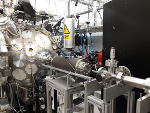End-to-end Simulation of LhARA
The simulation of the LhARA facility will be broken down into different parts:
- Definition of the input beam generated by the laser target interaction.
- With the option to collimate part of this beam due to the differential pumping plate.
- Initial distribution derived from smearing Phi from EPOCH simulations: /vols/ccap/data/LhARA/EPOCH_init.root
- Generated from rootPhiSmear.cpp root macro
- To generate: rootPhiSmear.cpp(float keLowCut, float keUpCut, int numPart, bool writeAscii, TString fileName)
Variable Units Detail KE MeV Sampled kinetic energy from EPOCH simulations scaled to 15 MeV. Theta rad Sampled angle theta from EPOCH simulations. Phi rad Sampled angle phi by fitting Gaussian to Theta distribution and sampling resulting Gaussian. X m x-position generated using initial Twiss value in CCAP-v4.0 code (assumed Gaussian distribution). Y m y-position generated using initial Twiss value in CCAP-v4.0 code (assumed Gaussian distribution). Z m z-position taken to be zero. PX MeV/c x-momentum calculated from Theta and pz. PY MeV/c y-momentum calculated from Phi and pz. PZ MeV/c z-momentum calculated from KE. P MeV/c Total momentum. GBx rad Normalised px as per GPT definition. GBy rad Normalised py as per GPT definition. GBz rad Normalised pz as per GPT definition. T s Time taken to be zero.
- Stage 1 tracking using GPT
- From the target for a drift of 5cm without space charge and then with space charge through to just before the vacuum window.
- Stage 1 tracking using BDSIM
- 5cm from the target through the end station.
- Stage 2 tracking using BDSIM - injection beam line.
- From the end of the last Gabor lens through a switching dipole that bends the beam away from the 90 deg vertical bend and into the injection transfer line of the FFA up to just before the septum.
- Stage 2 simulation using Zygoubi - FFA.
- The beam at the end of the Stage 2 injection simulation (using BDSIM) will be parameterised and then propagated through the FFA.
- Beam parameters after the extraction septum will be used to generate a beam for tracking downstream.
- Stage 2 tracking using BDSIM - high momentum in vitro beam line.
- Tracking from after the extraction septum, through the extraction line and switching magnet to the vertical bend and through the in vitro end station.
- Stage 2 tracking using BDSIM - high momentum in vivo beam line.
- Tracking from after the extraction septum, through the extraction line and switching magnet to the transfer line for the in vivo end station (including the option for sweeper magnets for spot scanning) and through the in vivo end station.
Simulation code
Code is stored in the repository ccap-sim.
Last modified
6 years ago
Last modified on Jan 16, 2020, 2:27:39 PM
Attachments (2)
-
WS_280220_Stage1Optics.2.pdf
(4.2 MB
) - added by 6 years ago.
Stage 1 Optics Overview 28/02/2020
-
280220-LhARA-invivo.pdf
(722.8 KB
) - added by 6 years ago.
HT Slides for Invivo Beamline Discussion
Download all attachments as: .zip
Note:
See TracWiki
for help on using the wiki.
